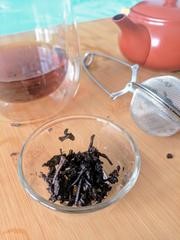This is a good question. Some teas do indeed have caffeine but how much compared to your average cup of coffee? There are studies that have said that tea leaves contain more caffeine than coffee beans. That doesn’t sound good. But there are some benefits to caffeine in small doses. Teas that do not have caffeine shouldn’t be confused with decaffeinated teas. A decaffeinated tea is a tea that had caffeine in it originally but the caffeine has been removed.

As was established in our previous post on black tea, all the main teas come from the Camellia sinensis plant varieties Camellia sinensis var. sinensis and its subspecies camellia var assamica. The teas, white, yellow, green oolong, pu-erh and black tea are harvested from one of the two varieties of the Camellia sinensis plant. Kukicha, a twig tea, is also harvest from this plant but the twigs and stems are used to make the tea rather than the leaves. Rooibos and Yerba Mate do not come from the Camellia sinensis plant. Rooibos is a red tea and comes from South Africa. It is a naturally caffeine free herb. More on Rooibos tea in a later post.
Yerba mate comes from the South American rainforest holly tree, Ilex paraguariensis. The South American trip Ache Guayaki tribe have had yerba mate from the mate gourd for it’s rejuvenative effects. There’s one benefit of Yerba mate! Nowadays, it seems a drink is made from the leaves of this holly tree, Ilex paraguariensis. More on Yerba mate in a later post.
Herbal teas may also be called herb teas of tisanes and fruit teas and usually an infusion of herbs, spices, fruits or any other plant. More on herbal teas in a later post.
Matcha comes from green tea and so does have caffeine in it. However, since it is the leaves of green tea powdered and dissolved in the water to make matcha, nothing of the leaf is unused resulting in a greater caffeine content than green tea. Again, more about matcha in a later post.
Chai tea is a mix of spices with black tea and so does contain caffeine. It originates from India where it’s called masala chai or spicy tea. Masala is a mix of spices. Chai usually contains 5 spices, green cardamom, cinnamon, ginger, black peppercorn and fennel seeds. These 5 spices are brewed together with the black tea then topped with milk and some kind of sweetener. More on chai in a later post.
Below is a table with the caffeine content of the more common teas, along with what plant the tea comes from, compared to a cup of coffee.
Caffeine Content of Tea
| Beverage | Plant origins | Caffeine content (milligrams/8 oz) |
| Coffee | Arabica plant or Robusta tree | 95-200 |
| Yerba Mate | South American holly tree, Ilex paraguariensis | 80 |
| Pu-erh tea | Camellia sinensis var sinensis | 60-70 |
| Black tea | Camellia sinensis var assamica | 40-70 |
| Chai | Black tea and spices | 50-70 |
| Matcha | Green tea | 45-60 |
| Green tea | Camellia sinensis var sinensis | 35-45 |
| Oolong tea | Camellia sinensis var sinensis | 37-55 |
| Yellow tea | Camellia sinensis var sinensis | 33 |
| White tea | Camellia sinensis var sinensis | 15-30 |
| Rooibos | South African herb | 0 |
| Herbal | Infusion of herbs, spices, fruits, any plant | 0 |
Depending on the type of tea you’re drinking there may be more or less caffeine in it and depending on what level of caffeine you want, you can pick your tea.
References:
Yerba Mate Vs. Coffee, Jessica Bruso, Oct 2017, URL: https://www.livestrong.com/article/367447-yerba-mate-vs-coffee/
Is Rooibos Tea Decaffeinated?, Lindsey Goodwin, Feb 2017, Url: https://www.thespruce.com/is-rooibos-decaffeinated-765282
Different Types of Tea and Caffeine Content, Garfield Medical Center, Oct 2016, Url: http://www.garfieldmedicalcenter.com/GMC-Blog/2016/October/Different-Types-of-Tea-and-Caffeine-Content.aspx
Caffeine and Matcha, The Whistling Kettle, Oct 2016, Url: http://www.thewhistlingkettle.com/info/index.php/blog/post/caffeine-and-matcha
Camellia sinensis, Wikipedia, Url: https://en.wikipedia.org/wiki/Camellia_sinensis
- My first time making scones - March 26, 2024
- Disappointing Visits to the Ripon and Plateau Farmers Markets - September 30, 2023
- The Ultimate Guide to Frozen Raw Dog Food: Benefits, Selection, and Transition Tips - September 25, 2023











